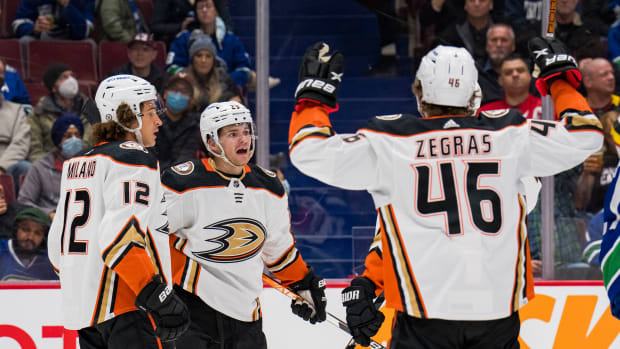Today is the beginning of a series of columns on the off-season plans for each of the 32 NHL teams. Each day, for the next month and a bit, we’ll break down what the outlook is for every franchise, and offer analysis of what to expect from them this summer. We’ll start the process in alphabetic order, with a look at the Anaheim Ducks.
2020-21 Record: 31-37-14
Finish In The Pacific Division: 7th
Salary Cap Space Available (As Per CapFriendly.com): $39.4 million
Restricted Free Agents: Isac Lundestrom, F; Sonny Milano, F; Sam Steel, F; Urho Vaakanainen, D
Unrestricted Free Agents: Zach Aston-Reese, F; Vinni Lettieri, F; Gerald Mayhew, F; Dominik Simon, F; Andrej Sustr, D
What Anaheim Has: A young, well-regarded new GM in Pat Verbeek; a head coach who’ll be under pressure to produce tangible results in Dallas Eakins; a core of young talent in forwards Trevor Zegras, Troy Terry, Mason McTavish and Maxime Comtois, and defenseman Jamie Drysdale; and a handful of veterans, including goalie John Gibson, winger Jakob Silfverberg and blueliner Cam Fowler; and one of the largest amounts of cap space of any team this off-season.
What Anaheim Needs: Scoring depth; proven veterans at forward to increase their goals-for total; more snarl on the back end.
What’s Realistic For Anaheim Next Season: Verbeek has a fresh mandate to rework the Ducks’ roster, and with so much cap space, he’s got the flexibility to add pieces to the puzzle, both for the immediate days ahead and for the long-term, by helping to facilitate trades between other teams in return for draft picks and prospects.
One of the biggest moves Verbeek may make could be the trading of Gibson, who has five seasons left on his contract, at an average annual cap hit of $6.4 million. Gibson’s individual numbers have been pedestrian at best of late (including a 3.19 goals-against average and .904 save percentage in 2021-22), but you have to factor in the reality he has been playing behind a leaky, soft Ducks defense corps. In the right circumstance – and with Anaheim perhaps retaining $1-2 million to make a deal more palatable – Gibson could be a large-impact player on a real Stanley Cup contender.
This coming season, that’s not likely to be the Ducks. Verbeek has a solid foundation of highly-skilled youngsters, but in a Pacific Division that will probably have improved teams in Vancouver and Las Vegas, and playoff locks like Calgary, Edmonton and Los Angeles, it’s going to be a tall order for Eakins to steer them to a post-season berth. Eakins wasn’t hired by Verbeek, so there will be speculation about his future as soon as the first slump of the year arrives for the Ducks.
Anaheim had wild swings in effectiveness last season, winning just two of their first nine games before posting an eight-game win streak through mid-November. That inconsistency is one of the hallmarks of a work-in-progress group, and the Ducks’ brutal second half of the 2021-22 campaign (in which they won just only four of their final 24 games) shows how far they still have to go to seriously challenge for a playoff spot. The retirement of longtime captain and star center Ryan Getzlaf leaves a big hole for them to fill, on and off the ice.
Verbeek’s considerable challenge is to add pieces to the puzzle that will make them harder on the puck, smarter in their own zone, and more of a capitalizing force on offense. It’s not going to happen simply because of a single roster move. They need improvement from within, as well as a boost from some new faces, if they’re going to move up the Pacific standings.



